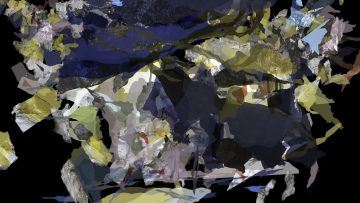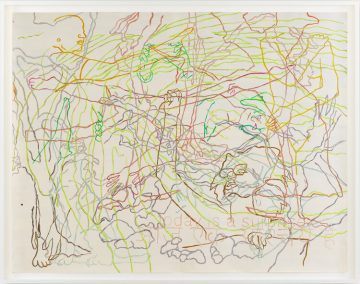by Timothy Don
The current economic crisis is crushing artists, museums, and galleries everywhere. In the San Francisco Bay Area, where I live, an exorbitant rental market made maintaining a practice difficult before this crisis hit. It’s even harder now. With 3QD’s permission, I’m going to use this column to talk about the work of some of the artists and art professionals I have met in the Bay Area. I ask you to support artists wherever you find them and however you can.

An explosion has occurred; a cave at the mouth of a prospecting site has been blown apart. Surfaces and shards of color and rock float in undefined space. Lonely, fragmented, incoherent, they seem to be searching for an order in which to gather, a language that would speak their place and purpose in creation. Guided by forces unseen, they look for hinges, sympathies, and affinities. Everything is present, yet nothing makes sense—until a coalescence transpires. Rhythm and energy emerge. With almost gravitational intention, shapes find their place, nestle together, and are transfigured, returning to themselves and becoming once more glowing rock, moving stream, dark cave. The entire experience transpires in a mere four minutes.
Astrophysicists tell us that at the moment of creation, when the universe gave birth to itself with explosive and ever-expanding energy, everything that exists now was present then in an infinitely dense point. A singularity. A black hole. A primordial cave. Breach, which records the image of a cave being blasted apart and then reassembling itself back into a cave, suggests that the universe is best imagined as a kind of cosmic cavern. The universe gave birth to itself from a cave, and as it cools and condenses, it becomes a cave.
At the same time, however, Breach recalls for us the devastating forces we have harnessed over the last several centuries in the name of hydraulic mining and the extraction of natural resources. Drilling, burrowing, caving: Having quite literally breached the gap between the immanent powers of nature and the technologies and willpower necessary to unleash them, the global mining industry hourly recapitulates the explosion from which earth was born—without any promise that its constituent parts can be reassembled. Breach functions simultaneously as a recording of the eternal, universal energies frozen in nature and as a reminder of the consequences of our attempts to unearth and harness those energies.
Breach is an artwork that asks us to consider the extent to which (like the prisoners in Plato’s mythical cave) we mistake our images of things for the things themselves while remaining blind to the deepest realities of nature. It challenges us to begin the task of liberating ourselves from the short-sighted and ultimately self-destructive ignorance by which we are enchained. Breach is a work that opens up the very possibilities it purports only to represent.
 Today Is a Surprise, by Ranu Mukherjee, 2018. Pigment, ink and milk paint on paper, 51″ X 66″.
Today Is a Surprise, by Ranu Mukherjee, 2018. Pigment, ink and milk paint on paper, 51″ X 66″.
One of the most unsettling aspects of contemporary existence is the sense that we are living simultaneously in two different time scales. Having slept late, we have abruptly awoken to the impact of human activity on the environment—and that its scale is so profound as to constitute a distinct geological age. Welcome to the anthropocene era, wherein cultural time overtakes geological time and the most common psychological state is an acute awareness of the possibility that the very near future will be drastically different (and most likely worse) than the present. As Ranu Mukherjee describes it, this is “shadowtime,” and we are living within it.
Shadowtime is also the name she has given to the body of work from which this piece comes. It is a long-term project aimed at the complex and particularly physical experience of colliding and shifting time frames: the cultural and the ecological, the socio-political and the climatological. Each piece in Shadowtime combines the tools of moving images (animation and choreography) with those of painting (color and line). The result, much like contemporary life, is a composite created from moments of urgency, intimacy, and action. The effect (again much like contemporary life) is a reconfiguration of human relationships according to terms drawn up by social and political forces and ecological events. In shadowtime, we are both subjects of and witnesses to the historically defining episodes, particularly those of identity, political isolationism, and race, that are physically intersecting around and through us.
Today Is a Surprise, for example, incorporates photographs that the artist shot in Sonoma in the aftermath of the devastating fires there, as well as images derived from various sources of anti-nationalist protestors in the US and India, victims of the tragic attacks in Las Vegas, dancers tangled in branches, and hands holding invisible devices. This painting illustrates the interconnectedness of ecology and culture, and the transformations that each is working upon the other. It makes one feel the pull and flow of relationships that we cannot apprehend but in which we are embedded. This is life today, the artist tells us. This is shadowtime.
Ranu Mukherjee is represented by Gallery Wendi Norris, San Francisco.
